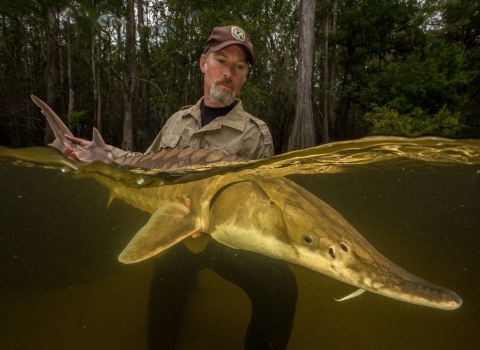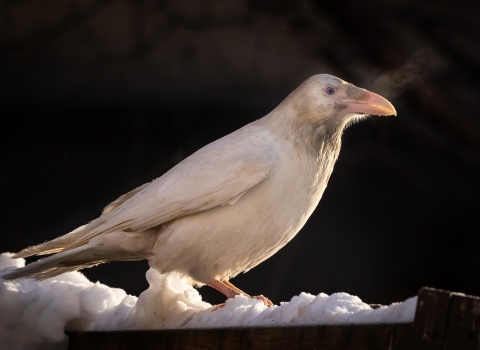"I was so relieved when they finally jumped up from the snow and flew off on their own. They looked very strong and headed right for the open water," said Greg Balogh (BAY-low), endangered species biologist with the U.S. Fish and Wildlife Service (Service).
Balogh, who transported the sea ducks from Anchorage to the small coastal village, gave the Savoonga students a brief biology lesson on the rare birds before they were released. In a happy finale to their last day of school for the year, six students assisted in the release of the six eiders on the snow-covered, ice-bound beach next to their school. Several dozen parents, teachers, students and other villagers watched as the eiders casually ambled on the snow, stretched their wings, and preened their feathers, composing themselves for flight after weeks of captivity. All cheered when the eiders finally took to the air for their home on distant open water on the Bering Sea, which is still largely covered with ice.
The spectacled eiders, which are listed as "threatened" under the Endangered Species Act, were found weak, starving and unable to fly in and near the village several weeks earlier. Local villagers contacted Balogh, who arranged for their immediate transfer to the Bird Treatment and Leaming Center (BTLC) in Anchorage. During the last few weeks, BTLC staff and volunteers nurtured and fed as many as fifty small fish per day to each duck until they regained enough strength to return to the wild. Alaska Airlines donated transportation for the sea ducks, which were carried in specially modified kennels.
What caused the eiders near fatal condition remains a mystery. "These eiders should be coming off of their wintering grounds with the fat content of gourmet ice cream, but for some reason, they are showing up with less fat than a small frozen yogurt" Balogh said. He points out that spring storms in the Bering Sea were especially relentless this year, and may have literally grounded birds away from their ocean-bome food. During winter, spectacled eiders travel to open spaces of water on the frozen sea, where they dive as much as 150 feet deep for their diet of small clams, fish and other sea life. By June, they usually move to mainland nesting grounds in coastal Alaska and Russia.
According to other Service biologists, El Nino-related sea conditions could be causing the deaths of many other species of sea birds off the coast of Alaska recently. These same oceanic changes may have contributed to the eiders condition. Eskimo walrus and seal hunters from Savoonga reported seeing groups of dead eiders on the sea ice miles away from the village soon after the series of storms lifted.
But the precipitous decline in the population of the spectacled eider pre-dates current El Nino conditions, Balogh said. The Alaska nesting population of spectacled eiders has plummeted more than 90 percent in the last twenty years, prompting the Service to list the spectacled eiders as a "Threatened Species" under the Endangered Species Act in 1993.
"Im elated we were able to save six of these guys. It felt great. But something else is driving their numbers down, something on their nesting grounds or in the Bering Sea. Unfortunately, shipping half-dead birds to Anchorage for an all-you-can-eat vacation cant solve the bigger problem," said Balogh.
"The successful release of these six eiders makes for a happy ending to one small chapter of this story, but the whole story of whats going on with these ducks and the entire Bering Sea ecosystem is still a big mystery with no end in sight," said Balogh.
FWS


